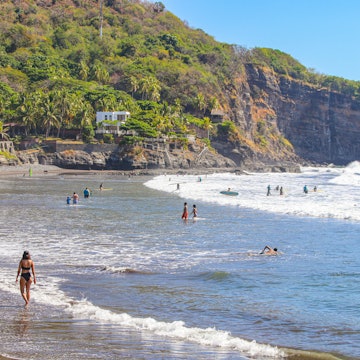
The best parks in Naples: from royal gardens to underwater Romans

Jan 22, 2022 • 5 min read

Escape the chaotic buzz of the city streets in Naples in one of its beautiful parks © MStudioImages / Getty Images
Naples is a busy city that demands stamina in buckets. Springboard for day trips to blockbuster Pompeii and volcanic Mt Vesuvius, this is a gloriously chaotic, high-energy destination.
Pack nerves of steel to navigate skinny streets on foot and a generous dose of Herculean endurance to take in the smorgasbord of sights littering Naples’ Unesco-listed historic center.
No wonder then that Naples’ hidden gardens, royal parks and salt-kissed seaside strips are a much-needed breath of fresh air for tourists and locals alike. When a retreat from the manic buzz of Neapolitan street life beckons, gravitate to one of these urban green spaces.
Villa Communale: best for a summer-evening passeggiata
The end-of-day passeggiata (stroll) is as sacrosanct in Naples as anywhere else in Italy and this long leafy park backing onto the Lungomare seafront is as fine a spot as any in downtown Napoli to promenade leisurely with locals, gelato or bag of freshly baked taralli rings in hand. Elegant stone fountains pepper the historical French-style gardens, laid out in the 18th century for the Bourbons to take some sea air in a style befitting of their regal status: until 1869 the private royal park or Passagio Reale (Royal Walkway) was open to the public just one day a year.
Views from the park of Castel dell’Ovo, Mt Vesuvius, the bay and outlying islands are particularly fine at sunset when Naples’ infamous volcano burns orange, pink and flame-red. Tennis courts, Europe’s oldest aquarium, bandstands and a generous peppering of open-air ‘chalet’ cafes and kiosks in the park provide other entertainment.
Orto Botanico di Napoli: best for bookworms and botanists
Story-book enchantment oozes out of every last vintage greenhouse and floral alley in Naples’ botanical gardens, gloriously green next-door neighbor to the city’s former royal almshouse where the ill and destitute sought food and shelter in the 18th century. If you’re dreaming of flopping on a bench in the shade and chilling with My Brilliant Friend or another Elena Ferrante Neapolitan novel for an hour or so, peaceful Orto Botanic di Napoli is the place to do it.
Founded in the early 19th century, the gardens squirrel away thousands of plant species – indigenous to beaches, deserts, peat bogs, rock gardens and wild lands all over the world. Exploring the ancient fern gully, citrus and palm groves are old-school adventurer highlights.

Real Bosco di Capodimonte: best for jogging, cycling and dog-walking
Its centerpiece palace commands an admission fee, but promenading like a king through the swathe of manicured green framing 18th-century Palazzo Reale di Capodimonte is free. Graceful fountains and period statues pepper the 134-hectare estate (331 acres), designed as a hunting reserve for Charles VII of Bourbon in 1742.
Local families with dogs on leads and bambini in pushchairs flock to the park at weekends to stroll its serpentine footpaths shaded by centurion palm and eucalyptus trees, cypresses, camellias and magnolias. Year-round, picnic tables here are prime real estate.
Some footpaths are off-limits to bicycles and a well-marked percorso vita (‘Life path’) looping around the park’s lake is reserved for speedier joggers and fitness enthusiasts.
Complesso Monumentale di Santa Chiara: best for instant escape and meditation
When Neapolitan street life in the loud, pounding centro storico threatens to overwhelm, make a hasty retreat to the historic center’s landmark Basilica di Santa Chiara and cloister garden where fragrant citrus trees mingle with lilac lavender blooms. Plop yourself down on a bench and lose yourself in a bewitching kaleidoscope of whimsical 17th-century wall frescos and exquisite majolica tiling. Hand-painted flowers, grapes, twirling vines and soothing rural scenes decorating 72 ceramic-tiled columns in the cloister guarantee instant escape from daily life.
If monastery gardens are your thing, the cloisters and hanging gardens at Certosa e Museo di San Martino with bay panorama in hilltop Vomero are also sublime.

Parco Virgiliano: best for spectacular sea views
When a break from the urban crowd beckons, gravitate to this terraced hillside park in the bourgeois neighborhood of Posillipo. The reward: spectacular coastal panoramas.
Allow ample time for gawping, gorging and swooning over the exhilarating big-blue seascape that unfolds from Parco Virgiliano: cliff-fringed Capri with its celebrity villas dripping in perfumed wisteria and bougainvillea to the south; and the islands of Nisida, Procida and Ischia polka-dotting the magnificent blue sweep of the Gulf of Naples southwest. Cast your eye west to admire the Bay of Pozzuoli and Sorrento Peninsula.
Top tip: don’t miss Naples’ poshest street market that springs into life by the park entrance on Viale Virgilio every Thursday morning.
Parco Vergiliano: best for romantics and poetry nerds
It is a tad crumbling and unkempt, but this is all part of the romantic charm of Parco Vergiliano, a small eclectic park in the off-the-beaten-track ‘hood of Piedigrotta (metro line 2 to the Mergellina stop) which holds the curious claim to fame of ‘home to the world’s longest Roman tunnel’. Stagger up endless steep steps to peer in the 700m-long gallery (2296ft) that once linked Naples and Pozzuoli.
Roman poet Virgil (70–19 BCE) lived much of his life in Naples. Niches in a dovecot-shaped stone vault in the park, empty following the transfer of his ashes to a neighboring church (since destroyed), once cradled decorative busts and cinerary urns. Lyric poetry lovers can pay their respects to Italian poet Giacomo Leopardi (1798–1837), another resident of Parco Vergiliano who died in Naples from cholera.
Parco Sommerso di Gaiola: best for biodiversity and aquatic action
Submerged Roman ruins and abundant sea life are the inspiring USP of this underwater park – a protected marine reserve best explored with snorkel and mask along marked itineraries or afloat a glass-bottomed boat. Tours organized by the park set sail along the coast to Baia di Trentaremi from the village of Marechiaro.
On dry land, enjoy exhilarating views of this precious strip of coastline from the clifftop perch of Parco Archeologico del Pausilypon, an archeological park safeguarding the 1st-century BCE ruins of a Roman villa complex. Catching a summertime performance beneath the stars in the Roman theatre here is pure magic.
You may also like:
Everything you need to know before your trip to Naples
The best things to do in Naples: livin' la dolce vita
Getting around Naples is easy with these top tips















